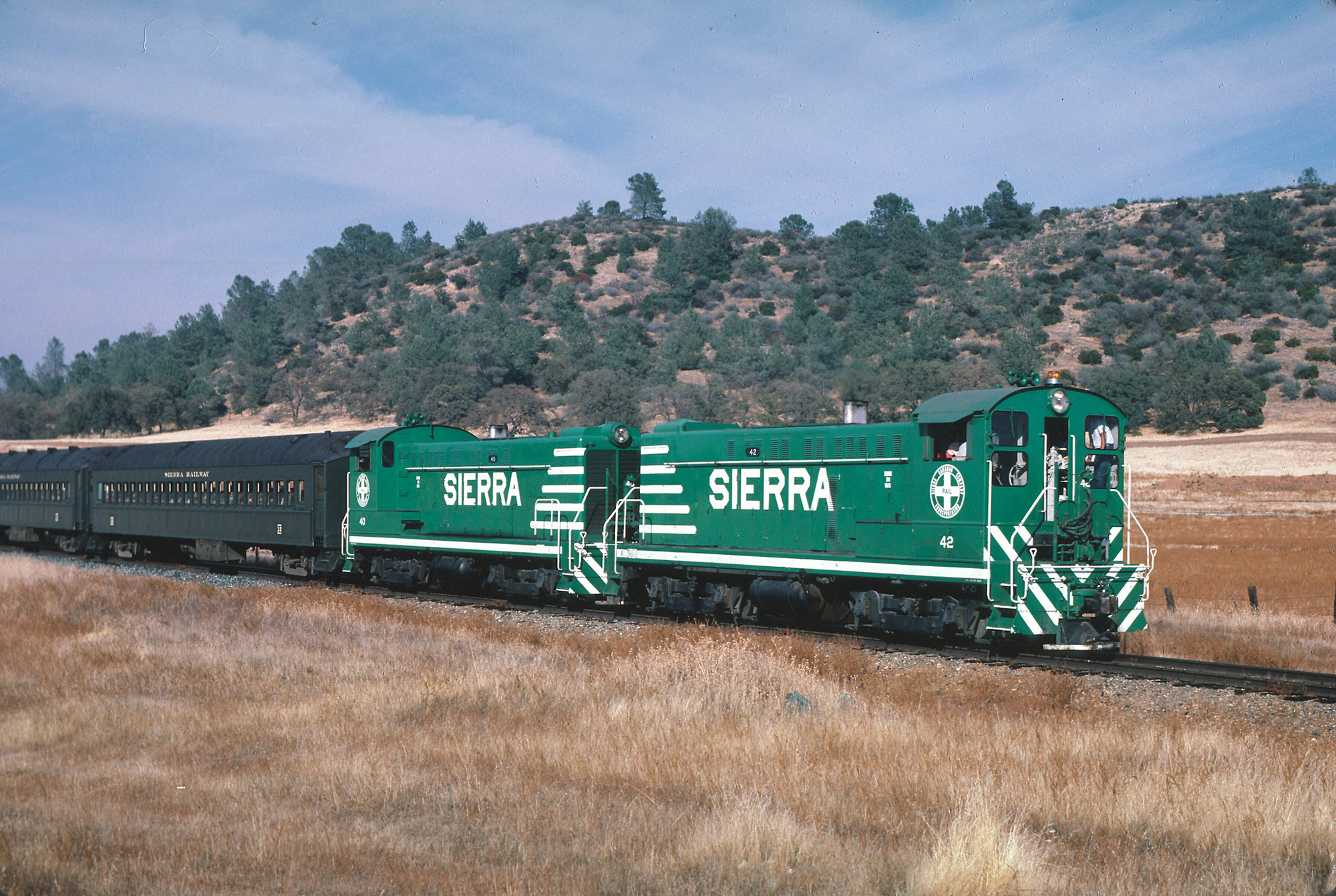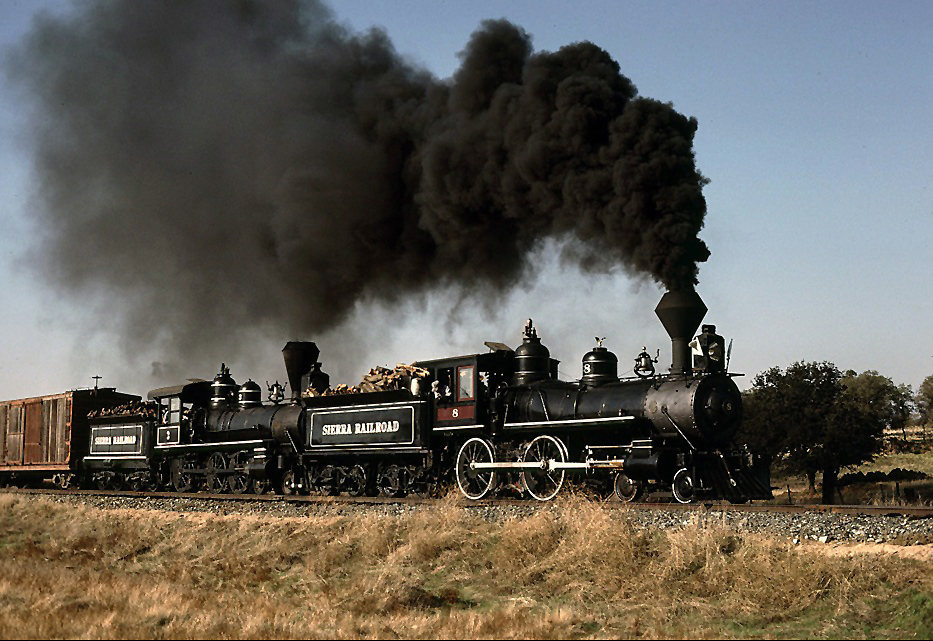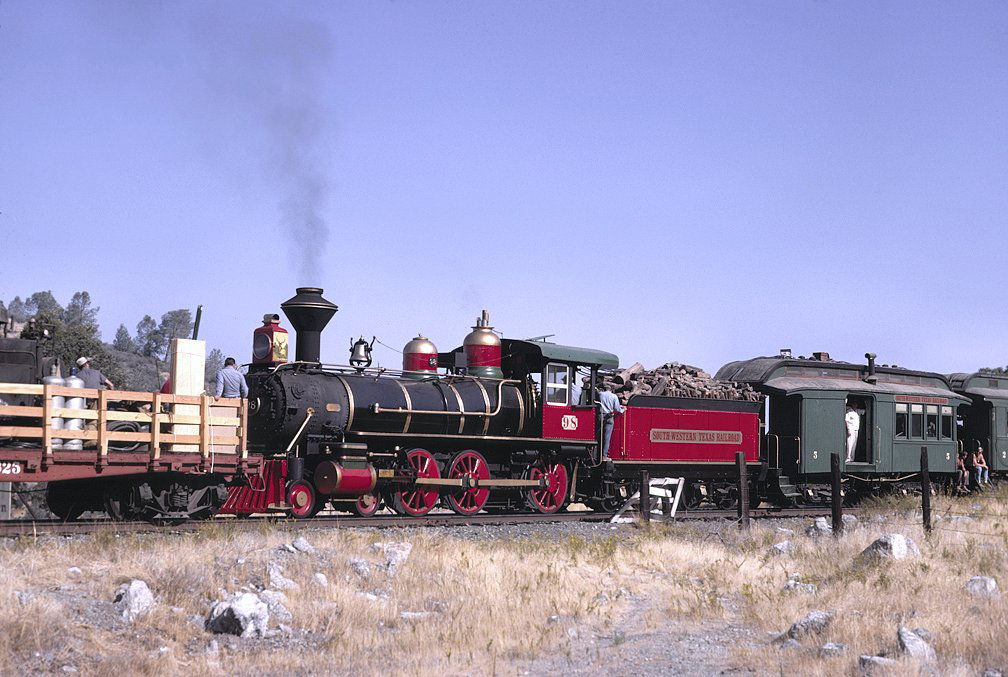Sierra Railroad: California's Historic Short Line
Published: July 19, 2024
By: Adam Burns
The Sierra Railroad, often dubbed the “Movie Railroad” for its frequent appearances in films and television, holds a rich and colorful history.
Stretching through the heart of California's Gold Country, its tracks have witnessed more than a century of industry, innovation, and storytelling.
This article delves into the captivating history of the railroad, from its inception during the late 19th century to its modern-day operations as a beloved heritage railway and thriving business enterprise.
 Sierra Railroad's two S12s, #40 and #42, lead an excursion at Keystone, California in October, 1985. Drew Jacksich photo.
Sierra Railroad's two S12s, #40 and #42, lead an excursion at Keystone, California in October, 1985. Drew Jacksich photo.Genesis
Early Ambitions: Harnessing the Gold Rush
The Sierra Railroad was born from the ambition and ingenuity sparked by the California Gold Rush.
By the late 19th century, the need for efficient transportation of timber, minerals, and agricultural products in Sierra Nevada's foothills became increasingly apparent. The railroad was envisioned as a vital link connecting these rich resources to broader markets.
Construction of the Sierra Railway, as it was originally known, began in 1897.
Founded by Thomas Bullock, Prince Andre Poniatowski, and William H. Crocker, the railway company aimed to construct a line from Oakdale to the gold mining town of Jamestown and onwards towards the Sierra Nevada.
Despite the challenges posed by rugged terrain and financial constraints, the determination of its founders brought the vision to fruition.
Early Operations: Building Momentum
The Sierra Railway opened its first section of track on March 15, 1897, reaching from Oakdale to Jamestown. This initial phase marked the beginning of a transformative era for the region.
The railway facilitated the transport of lumber from mills in the Sierras, agricultural products from the San Joaquin Valley, and gold ore from mining operations.
The railway's importance grew rapidly as it extended farther eastward. By 1900, tracks had reached Tuolumne, further cementing its role in the area’s economic development.
The Sierra Railway provided a lifeline for local communities, enabling easier access to markets and fostering growth in commerce and industry.
Overcoming Challenges: The 20th Century
The Impact of World War I and the Great Depression
The early 20th century brought both opportunities and challenges for the Sierra Railway. Participation in World War I saw an increase in demand for timber and other resources, which the railway was well-positioned to supply. However, the post-war years brought difficulties as the economy adjusted.
The Great Depression of the 1930s presented significant financial challenges. Reduced demand for timber, agricultural products, and mining resources led to a decline in revenue. However, the Sierra Railway found a lifeline in the evolving entertainment industry.
Hollywood's Favorite Railroad
The Sierra Railway gained fame as “Hollywood's Favorite Railroad.” Its picturesque scenery and historic charm made it an ideal shooting location for movies and television shows.
Beginning in the early 20th century, the railway featured in numerous productions, including classic westerns and adventure films.
Iconic films such as “The Virginian” (1929) and television series like “Petticoat Junction” (1963-1970) showcased the railway's unique appeal.
The steady stream of filming provided financial stability during tough economic times, ensuring the railway's survival and creating a legacy as a beloved part of cinema history.
The Transition to Sierra Railroad
In 1937, the Sierra Railway underwent a reorganization and emerged as the Sierra Railroad Company. This transition marked a new era of diversification and modernization. The company explored opportunities beyond timber and mining, focusing on agricultural products, livestock, and even passenger services.
Post-World War II, the company embraced technological advancements, acquiring diesel locomotives to replace steam engines. This modernization improved efficiency and reduced operational costs, allowing the Sierra Railroad to remain competitive in changing times.
 Sierra 4-4-0 #8 and 4-6-0 #3 leads an eastbound excursion out of Cooperstown, California in October, 1979. Drew Jacksich photo.
Sierra 4-4-0 #8 and 4-6-0 #3 leads an eastbound excursion out of Cooperstown, California in October, 1979. Drew Jacksich photo.The Modern Era: Heritage, Innovation, and Expansion
Preservation and Heritage Operations
The latter part of the 20th century saw a growing appreciation for the historical significance of railroads.
The Sierra Railroad responded by preserving its heritage and embracing tourism. The Sierra Railroad Historical & Modelers Society, formed by dedicated enthusiasts, played a pivotal role in this preservation effort.
Heritage train rides, often pulled by vintage steam locomotives, became a popular attraction.
Tourists and railroad enthusiasts flocked to experience the nostalgia of early 20th-century rail travel while taking in the stunning landscapes of California's Gold Country.
Revival and Expansion
The Sierra Railroad experienced a revival in the 1990s under new ownership. The Skunk Train, a historic line in Northern California, benefited from Sierra Railroad management, adding to the company’s portfolio and expanding its reach.
This period also saw increased focus on freight operations, providing essential services for modern industries.
Innovation continued with the development of dinner trains and other special events. These offerings combined historical charm with contemporary experiences, attracting diverse audiences and generating new revenue streams.
Sierra Northern Railway and the Present Day
In 2003, the Sierra Railroad merged with the Yolo Shortline Railroad to form the Sierra Northern Railway. This strategic merger further expanded the company’s operations, adding new routes and capabilities.
Today, Sierra Northern Railway operates freight services, passenger excursions, and holiday-themed trains, continuing its commitment to heritage and innovation.
The railway's dedication to preservation remains strong, with ongoing restoration projects and collaborations with historical societies.
The “Railtown 1897 State Historic Park” in Jamestown, established in partnership with the California State Parks system, serves as a living museum, offering visitors a glimpse into the railway's storied past.
Legacy and Continuing Impact
The Sierra Railroad's legacy is enduring, reflecting a blend of historical preservation, cultural significance, and economic resilience.
It stands as a testament to the transformative power of railroads in shaping the American West and the innovative spirit that ensures their relevance in modern times.
A Cultural Icon
The Sierra Railroad's frequent appearances in movies and television have cemented its status as a cultural icon. Its scenic routes and vintage equipment continue to capture the imagination of filmmakers and audiences alike. Visitors can walk in the footsteps of Hollywood legends, adding a unique dimension to their experience.
Economic Contributions
The Sierra Railroad has been a steady contributor to the local economy for over a century. By providing vital transportation services, promoting tourism, and creating jobs, the railway has supported the growth and sustainability of the communities it serves.
Educational and Community Engagement
The railway's educational programs and community initiatives foster a deeper understanding of historical and contemporary railroading. Schools, families, and community groups benefit from engaging experiences that highlight the technological, cultural, and environmental aspects of railway operations.
 Sierra Railroad 4-6-0 #3 during the filming of the "Great Bank Robbery," starring Clint Walker, in September, 1968 near Keystone, California. Drew Jacksich photo.
Sierra Railroad 4-6-0 #3 during the filming of the "Great Bank Robbery," starring Clint Walker, in September, 1968 near Keystone, California. Drew Jacksich photo.Conclusion
The history of the Sierra Railroad is a rich tapestry woven with ambition, resilience, and innovation.
From its early days serving the bustling industries of California's Gold Country to its status as a beloved heritage railway and cultural icon, the Sierra Railroad's journey through time is a testament to the enduring significance of rail transportation in American history.
As the Sierra Railroad continues to evolve and expand, it remains a cherished link to the past and a dynamic contributor to the future, inviting new generations to experience the magic of the rails.
Whether you're a history buff, a rail enthusiast, or simply seeking a memorable adventure, the Sierra Railroad offers a journey unlike any other—a journey through time, culture, and the picturesque landscapes of California.
All-Time Roster
| Number | Builder | Model/Wheel Arrangement | Completion Date | Heritage | Disposition | Notes |
|---|---|---|---|---|---|---|
| A | Plymouth | DLC6 | 1925 | HC Collins | - | - |
| 1 | - | 2-6-0 | - | Ex-Prescott & Arizona Central #1 | Sold to West Side Lumber Company. | - |
| 2 (1st) | - | 4-4-0 | - | Ex-Prescott & Arizona Central #2 | Scrapped 1899 | - |
| 2 (2nd) | New York Locomotive Works | 0-6-0 | 1889 | Ex-Northern Pacific | Sold to Lassen Lumber & Box Company, scrapped in 1940 | - |
| 3 | Rogers | 4-6-0 | 1891 | Ex-Prescott & Arizona Central #3 | To Railtown 1897 State Historic Park, Operational. | Known as the "Movie Star Locomotive" having appeared in several TV shows and movies. |
| 4 | Baldwin | 4-4-0 | 1882 | Ex-Northern Pacific #99 | Sold to West Side Lumber Company in 1917, scrapped 1938. | - |
| 5 | Schenectady | 0-6-0 | 1899 | Acquired new. | Sold to Hawaii Consolidated Railway; converted into a 2-6-2. Scrapped 1947. | Sierra Railway's first new locomotive |
| 6 | Baldwin | 4-4-0 | 1883 | Ex-Northern Pacific #144 | Sold to Atlas-Olympia; scrapped 1937. | - |
| 7 | Baldwin | 4-4-0 | 1882 | Ex-Northern Pacific #93 | Sold | Scrapped |
| 9 | Heisler | Heisler 2-Truck | 1899 | Acquired new. | Sold to Standard Lumber Company as #8, then sold to West Side Lumber. Scrapped 1947. | Served Angels Branch. |
| 10 | Lima | Shay 2-Truck | 1902 | Acquired new. | Sold to Hofius Stell & Equipment; then to Walville Lumber Company; then to Diamond Match Company. Scrapped 1942. | Served Angels Branch. |
| 11 | Lima | Shay 2-Truck | 1903 | Acquired new. | Sold to United Commercial Company; then to Pickering Lumber; then to Verdi Lumber; finally to Clover Valley Lumber. Scrapped 1952. | Served Angels Branch. |
| 12 | Lima | Shay 3-Truck | 1903 | Acquired new. | Sold to Pickering Lumber. Currently owned by the Pacific Locomotive Association. Stored serviceable | Served Angels Branch. |
| 18 | Baldwin | 2-8-0 | 1906 | Acquired new. | Currently privately owned in Merrill, Oregon. | Tender sold to Tidewater Southern in 1952 for use with 2-6-2 #132. Both locomotive and tender scrapped in 1955. |
| 20 | Baldwin | 2-8-0 | 1916 | Acquired new. | Sold to US Army (#6814); then to Kurth Lumber (#20). Scrapped 1955. | - |
| 21 | Climax | Climax 2-Truck | 1906 | Acquired new. | Sold to Sugar Pine Railway (#1). Resold to Grant Rock & Gravel; then to Stillwater Lumber; then to Zimmerman, Wells, Brown (dealer); sold to Sigardson & Bartholomew Logging; finally to Jamestown-Oregon Lumber. | Sierra's only Climax. Scrapped. |
| 22 | Baldwin | 2-8-0 | 1920 | Acquired new. | Sold to California Western (#41). Scrapped 1950. | - |
| 24 | Baldwin | 2-8-0 | 1912 | Ex-Nevada Copper Belt #3 | Scrapped 1955. | - |
| 26 | Baldwin | 2-6-0 | 1908 | Ex-Ocean Shore #6 | Sold to Davis-Johnson Lumber Company. Scrapped 1939. | - |
| 28 | Baldwin | 2-8-0 | 1922 | Acquired new. | To Railtown 1897 State Historic Park. | Operational |
| 30 | Baldwin | 2-6-2 | 1922 | Acquired new. | Sold to Howard Terminal Railway as #6 (rebuilt as 2-6-2T). Currently owned by the Pacific Locomotive Association, undergoing restoration back into a 2-6-2 arrangement. | Served Angels Branch. |
| 32 | Baldwin | 2-6-2 | 1923 | Acquired new. | Sold to Tidewater Southern (4/1940), renumbered 132. Scrapped 1955. | Original tender wrecked 1952, replaced with Sierra #18's tender. |
| 34 | Baldwin | 2-8-2 | 1925 | Acquire new. | Sold to Reed Hatch in 1962; acquired by private owner Fred Kepner in 1987.7 | - |
| 36 | Alco | 2-8-2 | 1930 | Acquired new | Sold to Reed Hatch in 1962; briefly used on White Mountain Scenic Railroad. Currently privately owned (Merrill, Oregon). | - |
| 38 | Baldwin | 2-6-6-2 | 1934 | Ex-Weyerhaeuser Timber Company #4 | Sold to Rayonier Inc. Currently privately owned (Merrill, Oregon). | - |
| 40 | Baldwin | S-12 | 1955 | Acquired new. | Scrapped (2008). | Sierra's first Diesel |
| 42 | Baldwin | S-12 | 1955 | Acquired new. | Stored out of service | Sierra's last new locomotive. |
| 44 | Baldwin | S-12 | 1951 | Ex-Sharon Steel #10 | Scrapped (2008) | - |
| 45 | EMD | GP9 | 1954 | Ex-Great Northern #667 | In service | - |
| 46 | EMD | GP9E | 1957 | Ex-Southern Pacific #5731 | Sold | - |
| 47 | EMD | GP7 | 1952 | Ex-Reading #607 | In service | - |
| 48 | EMD | GP20 | 1961 | Ex-Santa Fe #1162 | In service | Leased to Napa Valley Wine Train. |
| 50 | EMD | GP20 | 1961 | Ex-Santa Fe #1130 | In service | - |
| 52 | R.J. Corman/Railpower | RP20DB | 2014 | Acquired new. | In service | Built from ex-Yolo Shortline GP7u #135. Originally Santa Fe GP7 #2794. |
| 56 | R.J. Corman/Railpower | RP20GE | 2007 | ex-Union Pacific #2628 | In service | - |
| 131 | EMD | GP9 | 1957 | ex-Southern Pacific #5759 | In service | From Yolo Shortline |
| 132 | EMD | GP9 | 1957 | St. Louis Southwestern/Southern Pacific #823 | Stored | From Yolo Shortline |
| 133 | Homebuilt/Railpower | RP20DB | 2012 | Acquired new | In service | Built from ex-Texas & New Orleans/SP GP9 #436. |
| 134 | EMD | GP7u | 1952 | ex-Santa Fe #2704 | In service | From Yolo Shortline |
| 136 | EMD | GP7u | 1952 | AT&SF 2833 | In service | From Yolo Shortline |
| 1227 | Lima | 0-6-0 | 1914 | Southern Pacific | Under Restoration | Owned by the Golden Gate Railroad Museum. |
| 2608 | R.J. Corman/Railpower | RP20GE | 2006 | ex-Union Pacific #2608 | Out of service | - |
| 2609 | R.J. Corman/Railpower | RP20GE | 2006 | ex-Union Pacific #2609 | In service | - |
| 2612 | R.J. Corman/Railpower | RP20GE | 2006 | ex-Union Pacific #2612 | Out of service | |
| 2620 | R.J. Corman/Railpower | RP20GE | 2007 | UPY #2620 | Out of service | |
| 2652 | R.J. Corman/Railpower | RP20GE | 2007 | ex-Union Pacific #2652 | In service |
Recent Articles
-
Rio Grande 2-8-2 Locomotives (Class K-28): Specs, Roster, Photos
Apr 14, 25 10:24 PM
Rio Grande's Class K-28 Mikados were its newest narrow-gauge steam locomotives since the Mudhens of the early 1900s. Today, three survive. -
Rio Grande K-27 "Mudhens" (2-8-2): Specs, Roster, Photos
Apr 14, 25 05:40 PM
Rio Grande's Class K-27 of 2-8-2s were more commonly referred to as Mudhens by crews. They were the first to enter service and today two survive. -
C&O 2-10-4 Locomotives: Specs, Roster, Photos
Apr 13, 25 04:07 PM
Chesapeake & Ohio's T-1s included a fleet of forty 2-10-4 "Texas Types" that the railroad used in heavy freight service. None were preserved.


